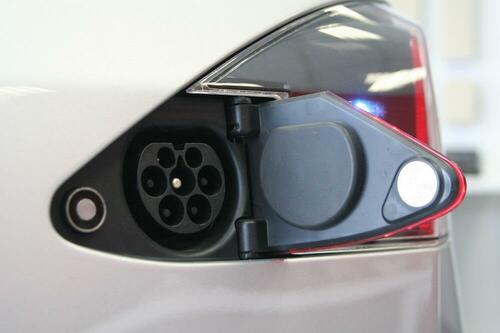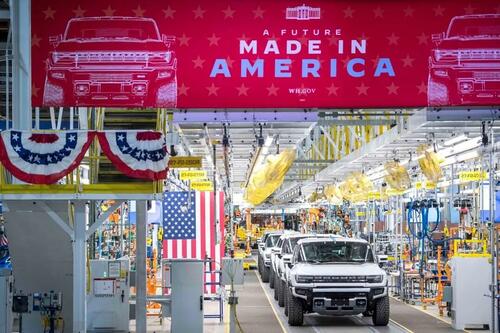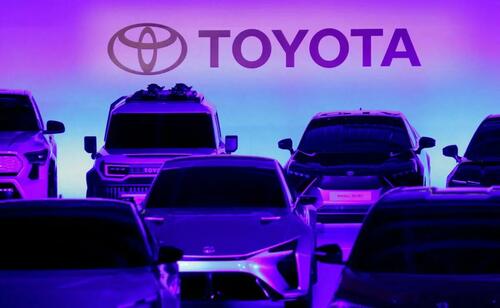EV are fantastic toys for rich people who have everything else and need to feel good "saving the planet" while staying put in their comfortable lifestyles.
For everybody else they are too expensive, have a limited use and range, cost a fortune to repair and belong to a dystopian future of smart cities where your every move is monitored.
Authored by Mark P. Mills via RealClear Wire,
This essay is based on the opening remarks delivered at a recent SOHO Forum Debate on electric vehicles.
If we could imagine a time machine bringing to New York City, an American citizen from the 19th century, odds are the one thing that would seem the most amazing about our time would be the proliferation of the personal automobile.
Big buildings, big cities, roads, nighttime illumination would all be
imaginable, even if different looking and greater in scale. But the one
thing radically different about modern daily life is the convenience and
freedoms that come from a car.

Yes, that 19th
century citizen would probably be puzzled by people staring at glowing
rectangles in their hands. In fact, the personal computer and the
personal car are co-equal in their transformative impacts. MIT historian
Leo Marx put it well when he wrote that: “To speak . . . of the
‘impact’ of ... the automobile upon society makes little more sense . .
.than to speak of the impact of the bone structure on the human body.”
The
centrality of the car in the social and economic structure of society
is evidenced by how citizens have voted with their pocketbook. A car is the single most expensive product that 98% of consumers ever purchase. Over
90% of American households own or have access to a car. Average
household spending on personal mobility is the second biggest expense
after mortgage or rent.
And there’s nothing to the trope that the
rising generations will abandon automobiles. A recent MIT analysis found
Millennials exhibit no difference in “preferences for vehicle
ownership” and in fact drive more miles per year than Boomers. As for
Gen Zs, the share of cars bought by that cohort has increased five-fold
in the past five years.
Finally, to finish framing why cars
matter, let’s consider what used to be called telecommuting, Zooming and
remote working, especially following the epic exodus caused by the
destructive Lockdowns of 2020. Surveys show the lockdowns accelerated a
trend that was already underway, one of a huge swath of Americans moving
to suburbs or rural areas. It’s a trend that invariably leads to a
greater need for cars and distances driven.
Now come politicians in a dozen states—and
the EPA via a creative exercise of regulatory authority—with plans to
to ban the right to purchase a car with an internal combustion engine,
the kind of car that 98% of Americans own, and the kind of car that 98%
of average-incomed Americans still buy. The goal of the bans is
not, we’re told, to deny any citizen the ability to own or afford a
useful car. Instead, as everyone knows, it is in service of the goal to
cut carbon dioxide emissions by mandating the use of so-called
zero-emission electric vehicles. EVs for all. The process of
“transitioning” to EVs for everyone, everywhere, we’re also told will be
painless because EVs are inevitably taking over the entire automobile
market because they are—it is said—simpler, better, and easier to use,
and “cleaner.”
And now the Orwellian-named Inflation Reduction Act
(IRA) promises a gusher of money to induce that transition. Let’s
stipulate the obvious – one doesn’t need subsidies and mandates to
convince people and businesses to buy products that are inherently
radically better and cheaper.
But, assuming that the inflationary
legislation isn’t reversed by a future Congress, the IRA’s push for an
energy transition will deploy $2 to $3 trillion, (when it’s fully
‘costed’ to include unfunded mandates and in-perpetuity subsidies), half
of which will be for EVs and related infrastructures. You can buy a lot
of obeisance with that kind of money. With so much money combined with
political mandates and PR momentum, we should not be surprised to find
no auto maker dare avoid genuflecting to the grand vision of an all-EV
future. But money can’t buy a change in the laws of physics and
underlying engineering realities.
The ostensible inevitability, the enthusiasm, the subsidies, and the mandates for EVs are anchored in three claims:
- That EVs will radically reduce global CO2 emissions.
- That EVs are cheaper and easier to fuel because, well, you can “just plug them in,” and
- That EVs will soon be cheaper than conventional cars because they are inherently simpler.
All three of these claims are simply wrong.
Start
with the core claim that “they’re simpler.” Yes, conventional cars have
complex thermo-mechanical systems. Engines and automatic transmissions
are made from hundreds of components, although mated with a very simple
fuel system, a tank holding a liquid with a one-moving-part pump. EVs,
inversely, have a simple motor made from a few parts. However, the EV
fuel tank is a complex electrochemical system made from hundreds,
sometimes thousands of parts including a cooling system, sensors, safety
systems, and a boatload of power electronics. EVs aren’t simpler,
they’re just differently complex.
The illusion of EV simplicity has relevance to the strike underway by the United Autoworkers Union. EVs do not entail less labor to build, but instead shift where the labor takes place. The data show
that, overall, while about 80 people are employed per 1,000
conventional cars produced, Tesla, the world’s biggest EV maker—for
now—employs about 90 people per 1,000 cars produced per year.
Seem
strange? Consider just the labor to make the two different drive
trains. Again, take Tesla and specifically its trend-setting Nevada “gigafactory”
where public data shows about 8 people are employed per 1,000 EV
drivetrains produced – that’s electric motor plus battery. The combined
employment at conventional engine and transmission
factories is just 4 people per 1,000 drivetrains. That’s the inverse of
the EV labor argument. And there’s more to the labor story, realities
that have implications for emissions and costs.
Look upstream at
the primary materials sent to the factories to fabricate the vehicles.
Steel and iron make up about 85% of the weight of a conventional car.
That upstream supply chain requires less than one person per 1,000
vehicles produced. Meanwhile, most of the weight of an EV is found in
more exotic, so-called energy minerals, from copper and aluminum to,
obviously, lithium, and also nickel, cobalt, manganese, and rare earths
like neodymium. That upstream supply chain employs roughly 30 people for
every 1,000 EVs. Of course, all that labor is elsewhere since the mines
and refineries are not in America.
But before turning to cost and emissions implications of the upstream realities, we need to address the claim that EVs are simpler to fuel.
It’s
obvious that the imagined all-EV future requires on-road fast-charging.
First, the total labor to deliver the same energy to EV fueling
stations is greater than it is for the gasoline infrastructure…
something that will necessarily, ultimately impact costs. But setting
that aside (and that’s a lot to set aside), the lie of the
simpler-to-fuel is in the nature of electrical engineering for
fast-charging batteries. The so-called superchargers offer, instead of
overnight fueling, 80% charge in 30 to 40 minutes. This is only fast if
it’s not compared to the 3 to 4 minutes it takes to fill up a gasoline
tank. Long refueling times will translate into long lines at EV fueling
stations as well as the need for five to 10 times more charging ports
than fuel pumps.
That won’t be convenient, simple, or cheap. Each
supercharger costs two to three times more than a gasoline pump. And,
because superchargers necessarily operate at 100 times the power level
of an overnight home-charger, that translates into staggering
requirements for grid infrastructure upgrades. Today roadside fuel
stations have the electric demand of a 7-Eleven; but convert those to EV
fueling station and every one of them will have the electric demand of a
steel mill – and highways will need thousands of them.
Enthusiasts
are either unaware of or profoundly naïve about the time and cost
challenges of all that. The naivety extends in particular regarding the
materials demands for the quantities of copper needed for all the wires
and transformers that will be required to replace cheap steel pipes and
tanks. And the metal demands of the electric infrastructure will
necessarily be piled on top of an unprecedented increase in demand for
metals and minerals to fabricate the EVs.
While copper is the long
pole in the tent, it is only one of the mineral challenges. The
realities of costs and emissions for EVs is dominated by a simple fact: a
typical EV battery weighs about 1,000 pounds to replace the fuel, and
the tank weighing together under 100 pounds. That half-ton battery is
made from a wide range of minerals including copper, nickel, aluminum,
graphite, cobalt, manganese, and of course, lithium. And to get the
materials to fabricate that half-ton battery requires digging up and
processing some 250 tons of the earth somewhere on the planet. Those
numbers, it’s important understand, are roughly the same no matter what
the specific battery chemical formulation is, whether it’s lithium
nickel manganese, or the popularly cited lithium iron phosphate.
And yes, that EV tonnage should be compared to the combined tonnage of metals and the weight of the oil used to produce and fuel a conventional car. Even if you compare those numbers, over a 10-year lifespan of both kinds of cars the EV still
entails a ten-fold greater extraction and handling of materials from
the earth, and far, far more acreage of land disturbed and,
unfortunately, often polluted.
The astronomical quantity of
materials needed for EVs has led proponents to claim that there are,
after all, enough minerals on the planet and there’s nothing to worry
about. And anyway, they say, we can recycle to reduce the monumental
materials requirements. But recycling will be irrelevant for a long time
since manufacturers claim EV batteries will last a decade. That means
there won’t be anything significant available to begin recycling until
the early 2030s, long after the world has had to face up to the biggest
expansion of global mining in history.
As for the underlying
geological resources to supply the suite of energy minerals: Of course
there are enough of all those on planet Earth, and even in America.
That’s irrelevant. What’s relevant is that the data show that, overall,
the mines operating and planned can’t supply even a small
fraction of the 400% to 7000% increase in demand for minerals that will
be needed within a decade to meet the ban-the-engine goals. What’s
relevant is that the IEA has told us we’ll need hundreds of new
mega-mines, and that it takes 10 to 16 years to find, plan and open a
new mine. You can, as they say, do the math on that.
The need to
supply astonishing quantities of battery materials is also where we find
the core problem with the claims for big EV emissions and cost savings.
Since over 70% of the price of an EV battery comes from the costs of just buying the basic materials needed – that means the future price of
EVs is dominated by the future costs of those basic materials and is
dependent on guesses about the future of foreign mining and minerals
industries, not the labor and automation prowess at domestic assembly
plants. Over the past half-dozen years, the often-cited long-run, rapid
decline in battery costs has slowed dramatically. And now prices have
increased some 20% since 2021. So far, that’s with EVs still under 10%
of total vehicle production. We’re still in early days of minerals
demands.
And it’s with the acquisition of key materials where we find flaws with the core claims for emissions. The energy
used and thus emissions from producing a pound of copper, nickel, and
aluminum, for example, is two to three times greater than for steel. The
numbers are higher for the other minerals. Importantly, as researchers
at the Argonne National Labs have pointed out, relevant data for all the
battery materials “remain meager to nonexistent, forcing researchers to
resort to engineering calculations or approximations.”
That
means every emissions claim is a rough estimate or an outright guess
based on averages, approximations, assumptions, or aspirations. There
are huge variables and uncertainties in the emissions from
energy-intensive mining and the processing of minerals used to make EV
batteries. The simple fact is that no one knows how much CO2 emissions will decline as materials production rises to build more EVs. And all of the key variables point to higher, not lower, emissions in the future.
The
energy used to obtain a pound of metal depends on the size, nature, and
location of the mine. For copper, that number can vary at least
two-fold, and for nickel by three-fold. Getting accurate information is
complicated by the fact that 80%–90% of relevant minerals are mined and
refined outside the U.S. and E.U. and will be for a long time regardless
of subsidies. And, since China refines 50%–90% of the world’s suite of
energy minerals for EVs, it’s relevant that its grid is two-thirds
coal-fired—and will be for a long time.
There is a dishonesty at
the center of all the facile claims about big EV emissions reductions.
In fact, nearly all studies making emissions claims are worse than
guesses, the estimates frequently cherry-pick low numbers for what’s
really happening upstream. A meta-study of 50 different technical
studies found the estimates of emissions varied by over 300%. And,
worse, that analysis exposed the fact that most emissions claims were
based on assuming use of a small 30 kWh battery. That’s one-third the
size of batteries actually used in most EVs. Triple the battery size and
you triple the upstream emissions – and you triple the demand and thus
price-pressure for the minerals.
Upstream minerals emissions not
only offset the savings from not burning gasoline but, as the demand for
battery minerals explodes, the net emissions savings shrink and could
even vanish. Reasonable, even likely scenarios will lead to EVs causing a
net increase in global emissions. Geologists have
long documented that ore grades have been and will continue declining.
That’s because global ore grades are declining – for the
non-cognoscenti, that means for each new ton of mineral there’s a steady
and unavoidable increase in the quantity of rock dug up and processed. A
decrease of just 0.4% in copper ore grade will require seven times more
energy to access the copper.
Unlike cars with internal combustion engines, it’s impossible to measure an EV’s CO2 emissions.
And, unlike cars where those emissions are the same wherever or
whenever the car is made or used, EV emissions vary wildly depending on
how it’s made and where it’s used. While, self-evidently, there are no
emissions while driving an EV, emissions occur elsewhere—not
only upstream before the first mile is ever driven, but also when the
vehicle is parked to refuel. The latter, emissions from the grid, is
also far more complex than simplistic forecasts assume. Real-world
emissions from charging depend on precisely where and exactly when it’s
done. The refuel emissions can vary from near zero on a sunny day in
some states and, in other states and times, to the same or more than
would have come from burning gasoline.
None of this means that the
lithium battery doesn’t deserve a pivotal place in history. Its
invention was consequential for many reasons, nearly all of which have
little to do with EVs. Nor do the inconvenient complexities of mining
and grids mean there won’t be many more EVs in the future. Today’s fleet
of nearly 20 million EVs globally—notably half of which are in
coal-burning China—will doubtless balloon to hundreds of millions of EVs
on global roads in the coming couple of decades. But even such dramatic
growth would mean that EVs would by then account for barely 15% of all
consumer vehicles, and far tinier share of industrial and commercial
vehicles.
By way of analogy, the future of EVs in land
transportation ecosystems will end up echoing, in market share terms and
for similar operational reasons, the role of helicopters in aviation.
Helicopters offer very different and, in many applications, far more
useful even essential features compared to conventional fixed-wing
aircraft. That’s why there’s a very significant $60 billion a year global market for helicopters. Even so, helicopters are only 15%
of the overall global aircraft market. While helicopters, like EVs, are
useful for a large number of applications, one would no more expect all
aviation to use helicopters than for all drivers to use EVs.
The
realities of physics and engineering mean that politicians pushing for
an all-EV future run a high risk. Quite aside from the eventual
discovery that EVs will disappoint with only a tiny impact on global CO2
emissions, the bigger impacts will come as consumers find vehicle
ownership costs and inconveniences both escalating. That will lead to
unhappy voters motivated by the key underlying reality: A car is the
single most expensive and critical product used by the overwhelming
majority of citizens.
Mark P. Mills is a Senior Fellow at the Manhattan Institute, author of the 2023 report, Electric Vehicles for Everyone? The Impossible Dream, and author of the 2021 book (Encounter Books), The Cloud Revolution: How the Convergence of New Technologies Will Unleash the Next Economic Boom and A Roaring 2020s. Mark is also part of RealClearEnergy‘s BrainTrust.









